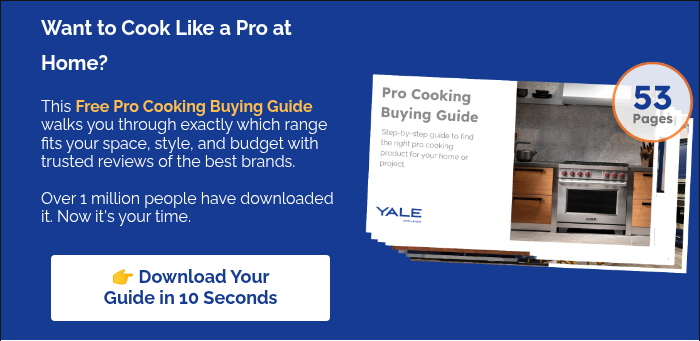How to Choose Appliances for Your Luxury Kitchen
October 10th, 2025 | 24 min. read

TL;DR: How to Choose Appliances for Your Luxury Kitchen
- Start with you: There’s no single “best”—match appliances to how you cook.
- Range: Gas (roast/broil, works in outages) · Dual Fuel (gas top + precise electric oven) · Induction (fastest, safest, easiest to clean/vent).
- Ventilation: Size by use—right CFM and 23–27" depth with a straight/short duct run.
- Ovens: Add wall, steam, or speed for precision, moisture, or faster cooking.
- Refrigeration: Counter-depth (value/clean look) · Pro (performance) · Integrated (flush design).
- Dishwashers: Prioritize racking & drying (AutoOpen/CrystalDry/steam+fan), not just decibels.
- High-impact upgrade: A workstation sink boosts daily workflow more than you expect.
If you’re remodeling, you probably have no idea where to start. I get it.
I’ve done two remodels myself, one in 2013 and another in 2017, and I can tell you firsthand that choosing appliances can feel overwhelming.
Not because there are too few options, but because there are too many.
The good news: it’s easier than you think once you match appliances to how you actually cook and live.
In Part 1 of our Kitchen Planning Series, we covered layout and workflow. Now it’s time to choose your appliances, category by category, from the range to the refrigerator to the dishwasher, based on real performance and how you’ll use them every day.
There is no single best appliance for everyone. But there is a perfect match for the way you cook, entertain, and live in your kitchen.
Let’s get started.
📌Skip Ahead:
- Ranges
- Venting
- Wall Ovens
- Steam and Speed Ovens
- Refrigeration
- Undercounter Refrigeration
- Dishwashers
- Specialty Appliances
- Sinks
- Key Takeaways
- FAQs
Free Webinar: How to Choose the Right Appliances for Your Kitchen — Oct 30, 12 PM EDT
Live, free session on Thursday, October 30 at 12:00 PM EDT. Choosing appliances can feel overwhelming—so many brands and features, and plenty of ways to overspend. In this fast, plain-spoken webinar, Yale Appliance’s experts share what actually matters so you can buy smarter.
What you’ll learn:
- Gas vs. Dual Fuel: what fits how you cook
- Pro-Style vs. Integrated: look & performance differences
- Steam vs. Speed Ovens: which one (if any) you need
- Best Dishwashers: quiet, clean results without compromise
- Common Buying Mistakes: how to avoid them
- Coffee Lovers: built-ins, pods, or a better option?
- Brands That Are Worth It: who does what best
✅ Save your free spot: Register here
Can’t make it live? Register anyway—you’ll get the recording and slide deck. Live attendees can ask questions during Q&A.
How to Choose Appliances for Your Luxury Kitchen
Ranges: Gas vs. Dual Fuel vs. Induction: Which Is Right for You?

When you start shopping for ranges, the first big question is fuel type.
Should you choose gas, dual fuel, or induction?
Each has strengths, and a few tradeoffs, depending on how you cook.
Gas Ranges
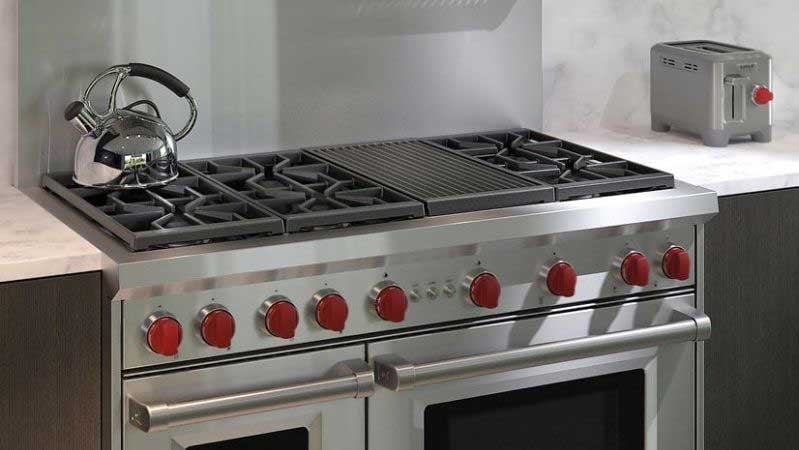
Gas ranges are a classic choice. With a gas stovetop, you see the flame, feel the heat instantly, and have excellent control for searing, sautéing, or roasting.
Gas ovens produce moist heat, which is better for roasting and especially for broiling. That’s why restaurants still rely on gas.
However, gas ovens are less precise for baking. Gas ranges also tend to have fewer smart features and self-clean options than higher-end dual fuel or induction models.
Choose gas if you want instant control and great roasting and broiling.
Pros
✔️Instant, visible heat for easy control
✔️Excellent for roasting and broiling
✔️Works during power outages
✔️Less expensive than dual fuel or induction
Cons
❌Less precise for baking
❌Harder to vent due to more heat and smoke
❌More difficult to clean because of grates and burners
❌Fewer smart features
All-Gas Ranges: Best Brands Summary
If you roast and broil more than you bake, start here.
This table compares burner power, true low-simmer control, and convection type across the major gas pro ranges, plus grill/griddle/French-top options for high-heat cooking.
| Sizes Available | Max Burner Output (BTU) | Lowest Simmer (Units as claimed) | Convection Type | Grill Option | Griddle Option | Colors/Finishes | Touch/LCD Controls | Self-Clean | French Top | |
| BlueStar RNB, Platinum | 30, 36, 48, 60 | 25,000 | 130° F | Large fan. Gas oven | Yes. 12 or 24-inch charbroiler | Yes. 12 or 24 inch | 1,000 + colors and trims | No | No | Yes |
| Wolf | 30, 36, 48, 60 | 20,000 | ~300 BTU | Fan convection, gas oven | Yes. Infrared | Stainless, knob controls | No | No | No | Yes |
| Miele | 30, 36, 48 | Not published | Twin-fan convection | Yes | Yes | Clean Touch Steel | Yes | Yes | Yes | No |
| SKS | 36 | Two at 23,000 | 100° F | "ProHeat" fan convection | No | Yes. Chromium | Stainless | Yes | Yes | No |
| Thermador Pro Harmony | 30, 36, 48 | 18,000 | 100° F (ExtraLow hold) | Fan-assist. Gas oven | Select SKUs | Yes. Electric | Stainless | No | No | No |
| Monogram | 30, 36, 48 | Two at 23,000 | ~140° F hold | Fan convection. Gas oven | Some SKUs | Yes | Stainless. Brass accents | Yes | Yes | No |
Dual Fuel Ranges
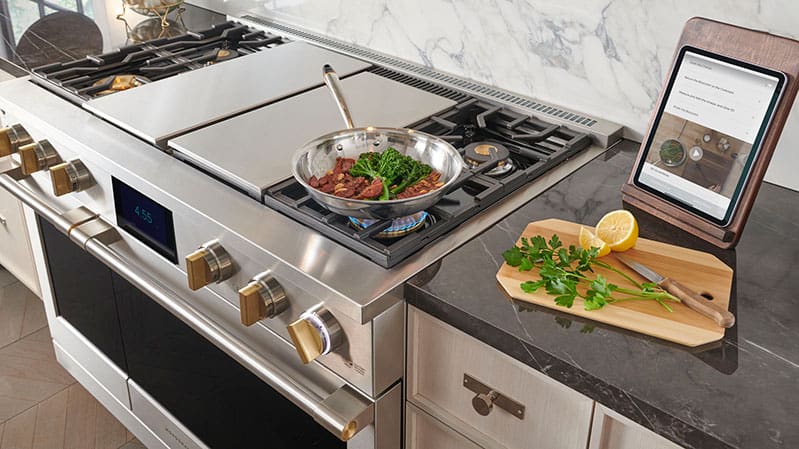
Dual fuel combines a gas cooktop with an electric oven. You get the best of both worlds before stepping up to induction.
You have the instant responsiveness of gas on top and the dry, even precision of an electric oven. This is ideal for baking or roasting when consistency matters.
Choose dual fuel if you cook on gas but want electric-oven precision for baking.
Pros
✔️Gas burners respond instantly
✔️Electric ovens deliver precise, even baking
✔️Ideal for cooks who bake frequently
✔️Often includes convection, steam assist, and guided cooking
Cons
❌More expensive than gas-only
❌Requires both gas and electric hookups
❌Electric ovens preheat slower than gas
❌Slightly more complex installation
Dual-Fuel Ranges: Best Brands Summary
For bakers who still love cooking on gas, dual fuel is the sweet spot.
Use this table to weigh burner output against electric-oven precision, convection systems, and any second-oven or steam features that change how you cook.
| Sizes Available | Oven Configuration | Convection | Max Burner Output (BTU) | Lowest Simmer (Units as claimed) | Special Cooktop Features | Special Oven Features | Touch/LCD | |
| BlueStar | 30, 36, 48, 60 | Single on 30, 36. Double on 48, 60 | Single | 25,000 | 500 BTU | French top, griddle, charbroiler. X-8 sealed burners | Electric oven with 8 modes | Yes |
| Wolf | 30, 36, 48, 60 | Single on 30, 36. Double on 48, 60 | Dual VertiFlow true electric | 20,000 | ~300 BTU | French top option, infrared grill, infrared griddle | Gourmet Mode, multi-rack | Yes |
| Miele | 30, 36, 48 | Single on 30, 36, 48 adds speed oven + warming drawer | Dual | Up to 19,500 BTU | 500 BTU | Griddle or grill options | MoisturePlus steam-assist. 48 adds speed oven | Yes |
| SKS | 30, 36 | Single on 36, Double on 48 with 18-inch steam-combi | Pure electric | 23,000 | 100° F hold | Built-in sous vide well. Two induction zones plus gas. Griddle | Steam-combi second oven on 48 | Yes |
| Thermador Pro Grand | 30, 36 | Single on 36, Double on 48 | Single | 22,000 | 100° F ExtraLow | Grill or griddle options. Star burners with ExtraLow | 48 can include steam oven + warming drawer | No |
| Monogram | 30, 36, 48 | Single on 30, 36, Double on 48 | Single/reverse-air | 23,000 | 140 degree | Griddle standard on many 48s. Some SKUs with grill | Air Fry, probe, Wi-Fi Smart HQ | Yes |
Induction Ranges

Induction is the fastest, safest, and most efficient way to cook. Like dual fuel, induction ranges use an electric oven for consistent, precise baking.
On the cooktop, induction is faster than gas, easier to clean, and easier to vent because there is no combustion. Boiling a pot of water can take about 90 seconds.
Keep a few limits in mind. Induction ranges draw 50 amps and can be susceptible to voltage spikes. You also cannot cook during a power outage.
In larger 48-inch induction ranges, you will not find built-in grills, sous vide zones, or French tops like you can with gas pro ranges.
Choose induction if you want maximum speed, safety, and easy cleanup.
Pros
✔️Fastest heat response, faster than gas
✔️Cool-to-touch surface that is safer for kids and pets
✔️Easy to clean with a flat glass surface
✔️Requires less ventilation
✔️Electric oven for precise baking
Cons
❌Requires magnetic cookware such as cast iron or stainless
❌No flame for visual feedback
❌Not usable during power outages
❌Susceptible to voltage spikes
❌Limited pro-size options without grill or sous vide top
Induction Ranges: Best Brands Summary
Fastest to boil, safest to touch, easiest to vent.
This table highlights zone layout, boost power, bridge options, and oven features so you can see which induction range fits your cookware and your routine.
| Sizes Available | Oven Configuration | Convection | Special Cooktop Features | Special Oven Features | Touch/LCD | Self-Clean | |
| BlueStar | 36, 48 | 36 single, 48 double | True/pure electric | Six zones, two bridges. Up to 7,400 W power zone. Matte glass | 7 inch touchscreen. True convection. Large trays fit | Yes | "Eco" cleaning mode |
| Wolf | 30, 36, 48 | 30/36 single, 48 double | Dual VertiFlow true convection | Boost on all zones. Up to 5,500 W zone. 7 zones on 48 | Gourmet presets. Multi-rack cooking | Yes (full-color) | Yes |
| Miele | 30, 36 | Single | Pure electric convection | Induction with TwinBooster. Knobs plus M Touch | Moisture Plus steam assist. requires plumbed water. Self-clean | Yes | Yes |
| SKS | 36 | Single | Rear-element pure convection | 11 inch center up to 7,000 W. Bridges. Pro style top | Steam-combi oven. SpeedClean | Yes | Yes (SpeedClean) |
| Thermador Pro Grand | 36 | Single | True/pure electric | Liberty flexible zones across cooktop | Standard electric convection modes | Yes | Yes |
| Monogram | 30, 36 | Single | True European convection | 5-element top on 36. Synchronized elements on griddle | Air-Fry/precision modes, Wi-Fi SmartHQ | Yes | Yes |
Quick Comparison Table
| Gas | Dual Fuel | Induction | |
| Best For | Roasting & broiling | Baking & all-around cooking | Fast, efficient, easy cleaning |
| Cooktop Heat Source | Open gas flame | Gas burners | Magnetic energy through cookware |
| Oven Heat Source | Gas | Electric | Electric |
| Speed | Moderate | Fast | Fastest |
| Oven Performance | Moist heat, great for roasts | Dry, precise, great for baking | Dry, precise, great for baking |
| Ease of Cleaning | Hard | Moderate | Easiest |
| Ventilation Needs | High | High | Low |
| Smart Features | Limited | Many | Advanced |
| Works During Power Outage | ✅ Yes | ⚠️ Sometimes | ❌ No |
| Energy Efficiency | Fair | Good | Best |
| Price Range | $$$ | $$$$ | $$$$ |
| Pro Options (Grill, Sous Vide) | Available | Some | Limited |
Local Tip
If you’re in Boston, Framingham, Hanover, Hyannis, Norton, or Nantucket, you can see gas, dual fuel, and induction ranges side-by-side in our showrooms.
Our team will show you how each performs — from how fast induction boils to how gas sears — and help you compare installation requirements, venting, and performance.
In most cases, we can deliver your new range the same or next day.
Ventilation: The Most Overlooked Appliance in the Kitchen
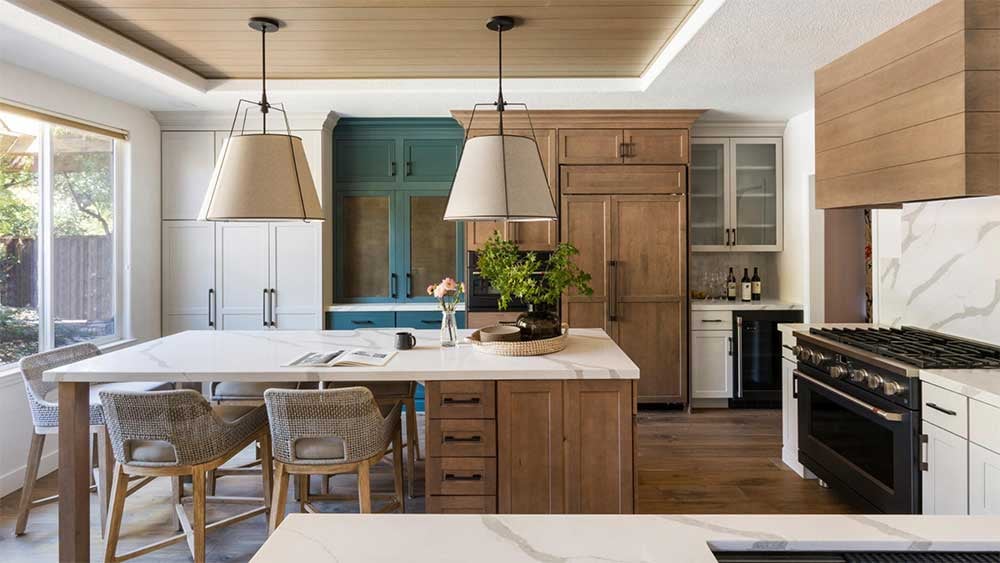
Ventilation is the one appliance nobody talks about until it’s too late.
You can have the best range or cooktop, but if your hood can’t handle heat, smoke, or grease, your cabinets get sticky and your kitchen smells like last night’s dinner for days.
Today’s homes are built tighter, with high-efficiency windows and insulation, so odors and airborne compounds stay trapped longer, circulating through your home instead of venting out.
Think of your hood as the kitchen’s exhaust system.
It’s not just about style; it’s about capture, coverage, and quality performance.
The Basics of Proper Venting
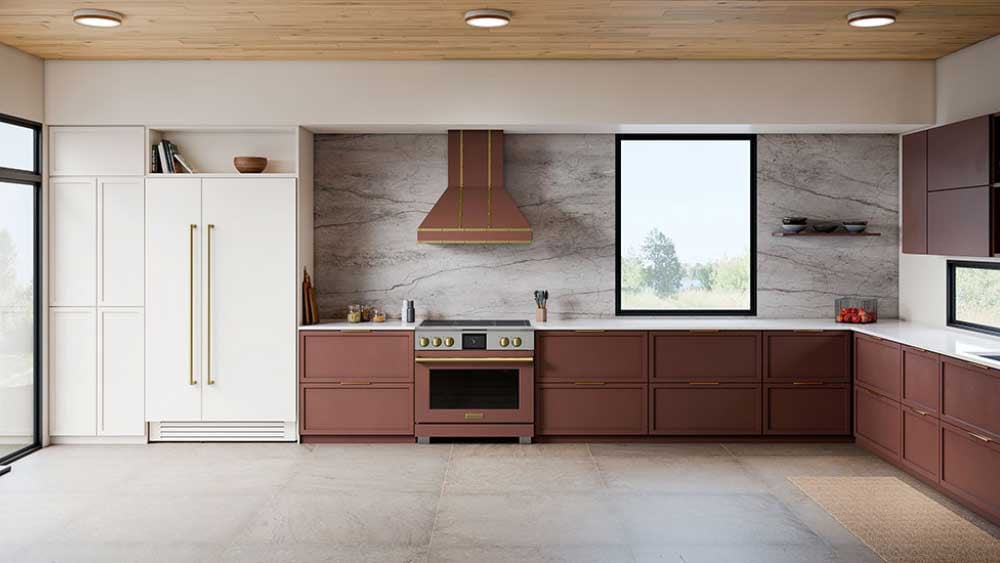
For real performance, focus on three factors: CFM, depth, and duct path.
CFM (cubic feet per minute) measures how much air your hood can move, and it varies by how you cook.
- A typical 30-inch range or cooktop needs at least 400–600 CFM.
- A 48-inch professional range needs 1,200–1,500 CFM.
There’s a big difference between boiling water and wok cooking, so size your hood based on how you actually use your range.
Depth matters more than most people realize.
You cook on the front burners, which sit about 22–23 inches off the wall, so you need at least 23 inches of capture depth.
Some hoods, like Wolf, extend to 27 inches for better coverage over high-BTU burners.
Ducting should vent straight up or straight out, not sideways or through multiple bends.
The straighter and shorter the duct, the better the airflow and the lower the noise.
Types of Ventilation
| Best For | Advantages | Considerations | |
| Wall Hoods | Most kitchens | Best capture area and performance | Requires proper ducting and clearance |
| Liners and Remote Blowers | Custom cabinetry or concealed looks | Quiet, seamless design | Needs planning and separate blower |
| Downdrafts | Tight retrofit spaces only | Hides when not in use | Not recommended for new construction; low performance |
| Overhead ceiling hoods | Open kitchens and islands | Modern aesthetic | Not recommended; poor capture at high height |
Best Ventilation Brands
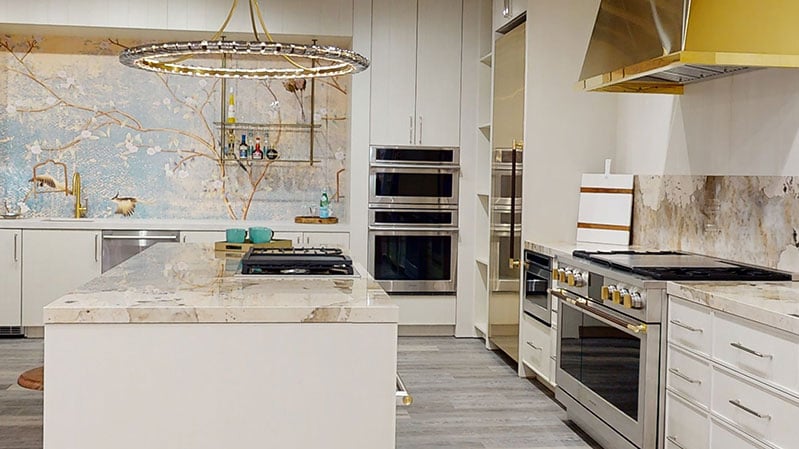
- Yale Appliance: Designed for New England homes with 5-year warranties, LED lighting, and dishwasher-safe baffle filters. Practical and built for real-world use.
- Wolf: Up to 27-inch capture depth and robust build for pro-style cooking. Excellent performance when paired with Wolf or Sub-Zero ranges.
- Monogram: Stylish and effective, with brass trim options and consistent airflow across sizes.
- Café Appliances and GE Profile: Ideal for moderate cooking with a good balance of style and power.
- AGA: The only hood you can customize for height, available in 17 colors and a wide range of finishes, a perfect match for design-driven kitchens.
- BlueStar: High CFM and customizable widths for professional-style applications.
- La Cornue: A luxury statement piece, designed to pair with their Château and CornuFé ranges for a cohesive look.
Quick Reference Table
| Recommended CFM | Minimum Hood Depth | Duct Direction | |
| 30" Standard | 400-600 CFM | 23" | Straight up or back |
| 36"-48" Professional | 1,200-1,500 CFM | 23-27" | Straight up or remoate blower |
| 30" Induction | 350-450 CFM | 23" | Straight up or back |
Final Tip
If you’re planning a remodel, ventilation should be part of the design conversation from day one.
Proper venting improves performance and ensures compliance with local codes, including make-up air rules that vary by town and CFM level.
Download our Free Ventilation Buying Guide to learn how to size, route, and vent correctly, including local code details for Greater Boston, Cape Cod, and Southern New Hampshire.
Or visit any Yale Appliance showroom in Boston, Framingham, Hanover, Hyannis, Norton, or Nantucket to see live venting displays and get personalized advice for your layout.
Wall Ovens: Precision, Flexibility, and Smarter Cooking

Nearly all wall ovens today are electric, and that’s a good thing. Electric ovens produce dry, even heat that’s perfect for baking.
Gas wall ovens are still available in a few brands, but they’re far less common and less consistent for precision cooking.
If you cook or entertain often, a double oven will make your life easier: one for roasting, one for dessert.
If you don’t cook for a crowd regularly, a single oven paired with a steam or speed oven offers better flexibility and newer technology.
Steam and Speed Ovens

Steam ovens use moisture to preserve flavor and texture, keeping food juicy yet thoroughly cooked.
Speed ovens combine microwave and convection technology. You can use each function separately or together, cooking faster while maintaining flavor without a dried-out microwave taste.
Both are excellent second-oven options depending on how you cook.
Steam ovens excel at roasts, vegetables, and fish. Speed ovens are perfect for reheating or cooking small meals fast.
Pros
✔️Electric ovens bake more evenly and precisely
✔️Eye-level access, no bending down
✔️Greater flexibility with steam or speed combinations
✔️Easy to design around for personalized cooking setups
✔️Cleaner look and ergonomic access
Cons
❌Requires more cabinetry and space
❌More expensive than a single pro range
❌Steam ovens need periodic maintenance (descaling)
❌Installation can be complex, especially when replacing existing cabinetry
Best Wall Oven Brands by Type
| Best Brands | Why It's Worth Considering | |
| Single Wall Oven | Miele, Wolf, Gaggenau | Precision control, guided cooking, and design flexibility |
| Double Wall Oven | Wolf, Miele | Reliable, even heat with self-clean and convection |
| Steam Oven | Miele, Wolf, Gaggenau, SKS | Preserves flavor and textured with moisture cooking |
| Speed Oven | SKS, Thermador, Monogram | Fast and efficient without compromising taste |
| French or Side Swing Doors | Thermador, Gaggenau, Monogram, Café, GE Profile, BlueStar | Easier access and elegant design |
| Value / Reliable Electric Models | GE, LG Studio, Bosch | Solid self-cleaning performance at lower price points |
Quick Comparison Table
| Single Oven | Double Oven | Steam Oven | Speed Oven | |
| Best For | Small kitchens, everyday baking | Frequent entertainers | Moist, healthy cooking | Fast reheating & crisping |
| Cooking Style | Traditional electric convection | Multi-course or family cooking | Gentle steam for texture | Microwave + convection combo |
| Heat Type | Dry, even | Dry, even | Moist heat | Hybrid |
| Installation Complexity | Moderate | High | Moderate | Moderate |
| Typical Price Range | $3K-$7K | $5K-$12K | $4K-$10K | $3K-$8K |
Local Tip
Installation is a huge part of buying wall ovens.
Make sure you clarify who handles installation: your cabinetmaker, general contractor, or appliance store.
Wall ovens need exact cabinet dimensions, power connections, and ventilation clearances.
At Yale Appliance, we have 18 dedicated installation teams in the Greater Boston area, specializing in wall ovens, steam units, and built-ins.

If you’re in Boston, Framingham, Hanover, Hyannis, Norton, or Nantucket, visit a showroom to test the controls, see door options, and understand fit requirements before you buy.
In most cases, we can deliver and install your new wall oven on the same or next day.
Steam and Speed Ovens: Faster, Healthier, and Smarter Cooking
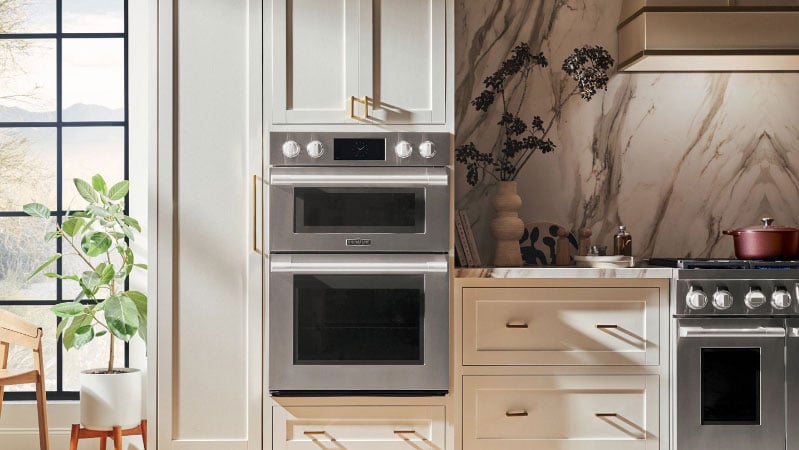
Steam and speed ovens are two of the most underrated appliances in the kitchen.
Most people don’t realize how much easier and better they make everyday cooking until they’ve used one.
If you’ve ever reheated chicken, roasted vegetables, or baked bread in a steam oven, you know the difference immediately.
Steam Ovens
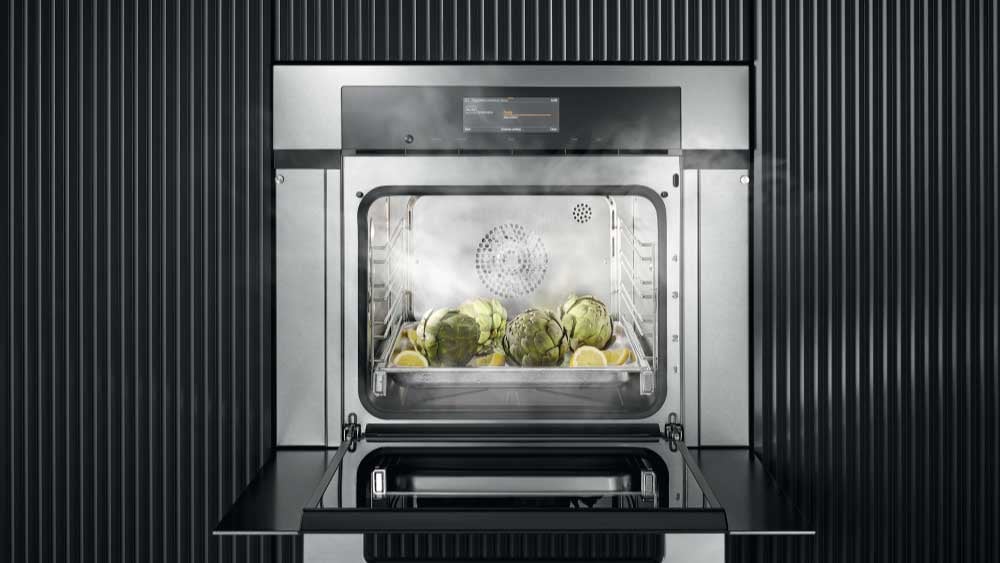
Steam ovens use moist heat to cook food more evenly while preserving flavor, nutrients, and texture.
Instead of drying food out like a traditional oven, steam locks in moisture and color, so your food comes out vibrant and tender every time.
I have the latest Wolf steam oven, and I can tell you everything tastes better in it: more vibrant, flavorful, and evenly cooked than in a regular oven. It is simple to use. Wolf and Miele ovens are so intuitive that there is almost no learning curve.
You can cook anything—salmon, chicken, vegetables, even bread—and it all comes out better than you expect.
Most brands now offer combi-steam ovens, which combine convection and steam so you can crisp and brown while still locking in moisture.
My Wolf even has a Reheat Crispy button. I press it, and it calculates time and temperature automatically. Leftovers taste freshly cooked, not reheated.
Pros
✔️Keeps food juicy and flavorful
✔️Healthier cooking, uses less oil
✔️Reheats food perfectly without drying out
✔️Doubles as a convection oven
✔️Simple guided controls in top models
Cons
❌More expensive than a standard oven
❌Needs descaling or filter maintenance
❌Requires a water tank or plumbed line
❌Smaller capacity than a full-size oven
Best Brands: Wolf, Miele, Gaggenau, SKS
Speed Ovens

A speed oven combines microwave and convection technology. You can use each separately or together.
This lets you cook up to 50% faster without losing texture or flavor.
No more rubbery pizza or soggy leftovers.
You can bake, roast, or reheat, and everything still browns and crisps like it came from a regular oven.
Speed ovens are especially useful in smaller kitchens around Boston or condos where space is limited but performance matters.
Pros
✔️Cooks 30–50% faster than a conventional oven
✔️Keeps crispness and browning
✔️Replaces the need for a separate microwave
✔️Compact and fits in most cabinetry
Cons
❌Smaller interior capacity
❌May require a specific cutout size
❌Limited broiling power vs. a full oven
Best Brands: SKS, Thermador, Monogram, Miele
Steam vs. Speed: Which Is Right for You?
| Steam Oven | Speed Oven | |
| Cooking Method | Steam + convection | Microwave + convection |
| Best For | Moist, tender cooking | Fast reheating or small meals |
| Results | Juicy, vibrant, flavorful | Crisp, hot, and evenly browned |
| Health Benefits | Retains nutrients, uses less oil | Less oil, faster cooking |
| Ideal dishes | Fish, chicken, veggies, bread | Pizza, casseroles, leftovers |
| Learning Curve | Easy with guided models | Easy |
| Maintenance | Descaling or cleaning tank | Minimal |
| Typical Size | 24-30 inches | 24-30 inches |
Best Combinations
If you’re designing a wall oven stack, the best setup for most kitchens is:
- Single wall oven + steam oven: for everyday cooking, baking, and healthy meals.
- Single wall oven + speed oven: for families or smaller kitchens where you want fast, crisp results.
Designers often place steam or speed ovens above the main oven for comfort and visual symmetry.
Local Tip
We demo steam and speed ovens five days a week in our showrooms; see them in action before you buy.
Click here for our Event Schedule to plan your visit and see real cooking examples.
For more information, you can also download our Free Steam and Speed Oven Buying Guide, featuring tips, comparison charts, and the best brands to consider.
Refrigeration: Counter-Depth vs. Professional vs. Integrated — What’s the Real Difference?

If you’re remodeling your kitchen, choosing a refrigerator can be confusing.
You’ll hear terms like counter-depth, professional, and integrated. What do they mean, and which fits your kitchen?
Let’s break it down.
Counter-Depth Refrigerators
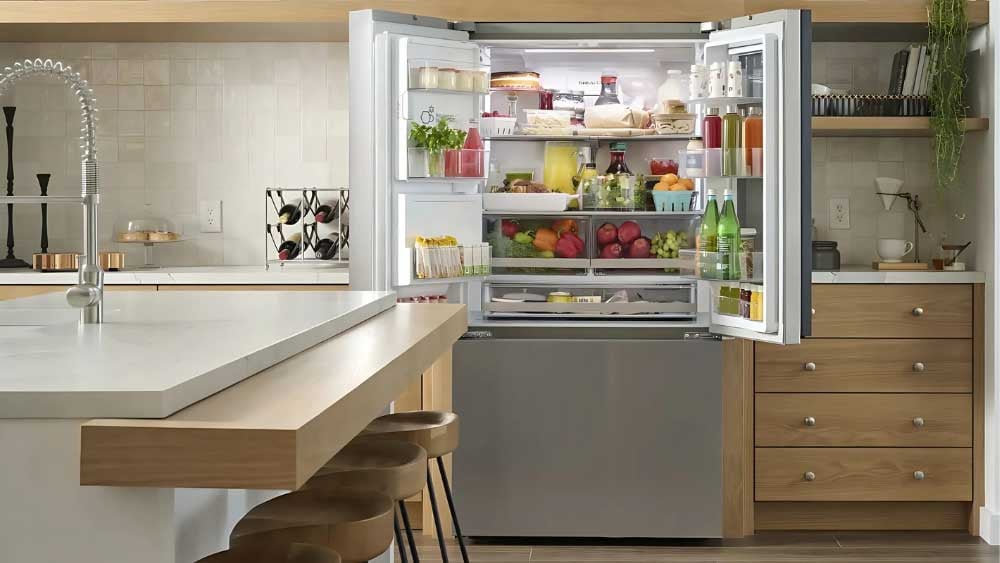
Counter-depth refrigerators are the shallowest and most affordable built-in option.
They sit roughly even with your cabinets for a cleaner, more built-in look than a freestanding model.
Inside, the layout is similar to a standard refrigerator.
You’ll usually see a bottom freezer with French doors or a side-by-side.
They’re great if you want a sleek look without custom cabinetry or the higher installation cost of professional or integrated models.
Choose counter-depth for a built-in look at the best price.
Pros
✔️Shallower depth for a built-in lookz
✔️More affordable than pro or integrated models
✔️Easy to replace or upgrade later
✔️No cabinet modification needed
Cons
❌Smaller interior capacity (less cubic footage)
❌Fewer customization options
❌Shorter lifespan than built-ins
Best Brands: LG, Café, Bosch
Professional Refrigerators

Professional refrigerators are what many picture in a high-end kitchen.
You’ll recognize the stainless front, top-mounted compressor, and industrial-style handles.
They look impressive, perform well, and are built to last.
Many feature twin compressors, stainless interiors, and more consistent temperature control than counter-depth models.
A professional refrigerator is still technically counter-depth.
The cabinet body sits flush with your cabinetry, but the doors and handles protrude slightly.
Choose professional for the iconic look and upgraded performance.
Pros
✔️Iconic professional look
✔️Better shelving, airflow, and construction quality
✔️Larger capacity and twin compressor options
✔️Stronger temperature and humidity control
Cons
❌More expensive than counter-depth
❌Door protrudes past cabinetry
❌Heavier and requires professional installation
Best Brands: Sub-Zero, Monogram, True, BlueStar
Integrated Refrigerators
.jpg?width=799&height=450&name=Thermador-Built-In-Refrigerator-Kitchen-Installation-with-Custom-Cabinets-(1).jpg)
Integrated refrigerators are the top of the design ladder. They sit completely flush with your cabinetry, so the fridge disappears into the kitchen.
Even the hinges are hidden, and the door panels align with surrounding cabinets.
The result is a seamless, minimalist aesthetic.
Integrated models are ideal for a discreet, high-end look.
You trade a little storage capacity for the sleek design and pay more per cubic foot.
Choose integrated for a fully flush, furniture-like installation.
Pros
✔️Completely flush, furniture-like design
✔️Hidden hinges and seamless cabinetry fit
✔️Custom panel or stainless finish options
✔️Quietest and most energy efficient
Cons
❌Most expensive to install
❌Smaller capacity due to shallower depth
❌Harder to retrofit into existing cabinetry
Best Brands: Sub-Zero, Thermador, SKS
Quick Comparison Table
| Counter-Depth | Professional (Pro) | Integrated | |
| Look | Near flush with cabinets | Commercial stainless, slightly protrudes | Completely flush, invisible |
| Depth | ~24-27" | ~30-31" | ~25" |
| Compressor Location | Rear-mounted | Top-mounted | Rear-mounted |
| Finish Options | Stainless steel | Stainless with some color customization | Custom panels or stainless |
| Capacity | Moderate | Large | Smaller |
| Cost Range | $1,500-$4,000 | $10,000-$20,000 | $6,000-$12,000 |
| Installation Complexity | Low | Moderate | High |
| Best Brands | LG, Café, Bosch | Sub-Zero, True, Monogram, BlueStar | Sub-Zero, Thermador, SKS |
Pro Tip: Columns Are Changing Everything

Column refrigeration, separate full-height refrigerator and freezer units, is one of the fastest-growing categories in high-end kitchens.
You can mix and match sizes, add wine storage or convertible drawers, and place them anywhere: kitchen, pantry, or bar area.
Top brands such as Sub-Zero, Thermador, Monogram, SKS, and True offer column options in multiple widths for complete design flexibility.
Local Tip
Delivery and installation are the hardest parts of buying a refrigerator, especially with integrated models.
Make sure you have experienced installers, particularly with newer systems such as Thermador and SKS multi-drawer integrated units that require precise cabinet alignment and door calibration.
Click here to download our Free Counter-Depth Refrigerator Buying Guide.
We will show you every major brand, style, and configuration, and in most cases, we can deliver and install the same or next day on in-stock models of any type of refrigeration.
Secondary Refrigeration: Drawers, Beverage Centers, and Wine Columns

If your main refrigerator is the workhorse of your kitchen, secondary refrigeration is the convenience you’ll wonder how you lived without.
Whether it’s refrigerator drawers under your island, a beverage center by the bar, or a wine column in the dining room, these appliances add flexibility and everyday luxury.
Refrigerator Drawers
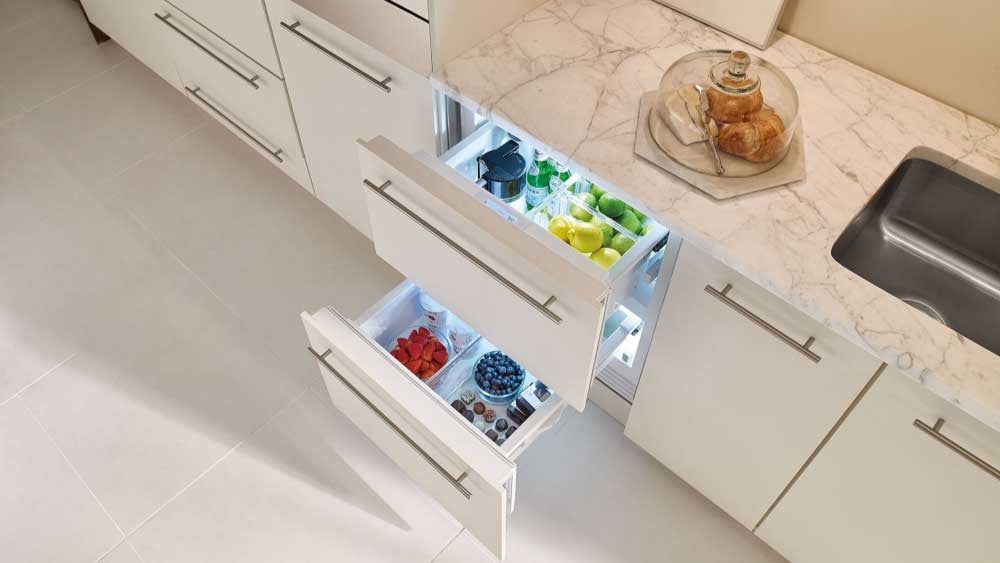
Refrigerator drawers are one of the most useful upgrades to consider.
They can hold almost anything: drinks, produce, snacks, or even party trays.
In my house, that’s where my daughter keeps her Poppi sodas, so she doesn’t have to open the main refrigerator.
They’re perfect for point-of-use convenience wherever you need extra cold storage, including under an island, in a prep area, or even outdoors.
Pros
✔️Adds storage exactly where you need it
✔️Ideal for snacks, drinks, or produce
✔️Saves space in the main refrigerator
✔️Works beautifully under counters or in islands
Cons
❌Limited capacity compared to a full fridge
❌Needs a dedicated electrical circuit
❌Pricier per cubic foot than standard refrigeration
Best Brands: Sub-Zero, True, Yale Appliance
Beverage Centers

Beverage centers are mini refrigerators for adults, designed for wine, seltzer, soda, or beer.
They’re stylish, quiet, and built to last, with options for dual temperature zones to chill wine and sparkling water in the same unit.
Important: never build in a freestanding model. Without front ventilation, the compressor overheats and fails prematurely.
Pros
✔️Keeps beverages organized and visibleZ
✔️Perfect for bars, kitchens, or basements
✔️Available in stainless, panel-ready, or glass-door styles
✔️Some models feature dual temperature zones
Cons
❌Not for perishable food storage
❌Less insulation than full refrigerators
❌Some models can be louder if not installed properly
Best Brands: True, Sub-Zero, Yale Appliance, Monogram
Wine Refrigeration

Dedicated wine refrigeration used to be a luxury for collectors, but it’s now a common upgrade in high-end kitchens and bar areas.
Wine coolers maintain precise temperature and humidity, protecting your investment and enhancing flavor.
Many models offer dual zones for reds and whites, UV-resistant glass, and low-vibration compressors to preserve taste and aroma.
Pros
✔️Keeps wine at the perfect serving temperature
✔️Dual-zone options for red and white wine
✔️UV protection and vibration control
✔️Available as undercounter or full-height columns
Cons
❌Dedicated for wine only, not for food or other drinks
❌Needs stable room temperature for accuracy
❌Adds cost and often requires custom cabinetry
Best Brands: Sub-Zero, True, Yale Appliance
Quick Comparison Table
| Best For | Typical Size | Temperature Zones | Best Brands | |
| Refrigerator Drawers | Drinks, snacks, produce | 24" | 1-2 | Sub-Zero, True, Yale Appliance |
| Beverage Centers | Wine, soda, seltzer, beer | 15-24" | 1-2 | True, sub-Zero, Monogram |
| Wine Coolers / Columns | Red & white wines | 15-30" | 2 | Sub-Zero, True, Yale Appliance |
Local Tip
Secondary refrigeration is about making your kitchen work smarter, not just bigger.
If you’re in Boston, Framingham, Hanover, Hyannis, Norton, or Nantucket, stop by a Yale Appliance showroom to see refrigerator drawers, beverage centers, and wine columns in action.
You’ll get real design advice on placement, electrical needs, and ventilation, plus see which models fit best in your space.
Or download our Free Undercounter Refrigeration Buying Guide, featuring installation tips, reliability insights, and brand comparisons from over 37,000 service calls across Greater Boston and Cape Cod.
Dishwashers: What Really Matters (and What Doesn’t)

Of all the appliances in your kitchen, the dishwasher may be the most used and the least understood.
Only a few things truly matter: quietness, washing and racking, and drying performance.
Quietness
If your kitchen opens to your living room, noise matters, but not as much as you think.
Anything under 44 decibels is effectively silent; below 40, only pay more if you gain other features. Pro tip: don’t pay just for silence. Pay for performance.
Wash Systems and Racking
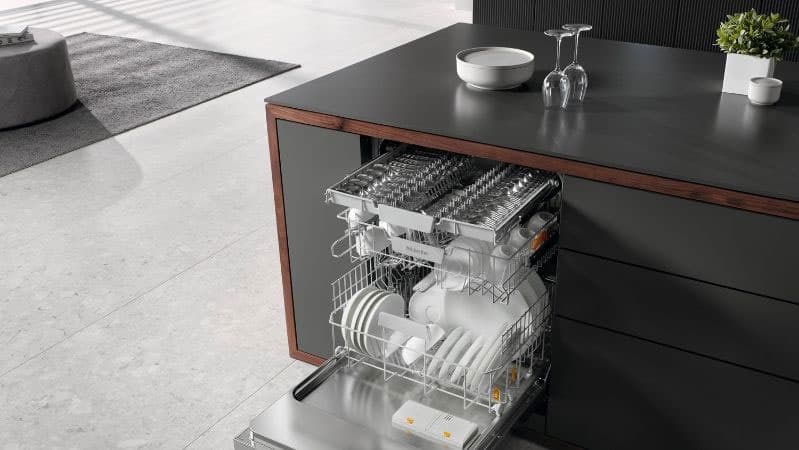
This is where dishwashers really differ.
Most brands wash well, but baskets and racking make the biggest everyday difference.
Miele’s better series racks are highly flexible, holding everything from vases to the tops of baby bottles.
KitchenAid’s rack system also makes it easier to load pans and large plates without blocking spray arms.
When you compare, look for:
- Stainless steel interior: resists odors and retains heat for better drying.
- Adjustable racks: accommodate tall cookware and stemware.
- Third rack: ideal for utensils, small bowls, and lids.
Most better models now include a third rack, but Miele, Bosch, and KitchenAid offer the most versatile designs.
Best Brands for Wash Systems and Racking: Miele, Bosch, KitchenAid, LG.
Drying Systems

Drying is the most overlooked part of a dishwasher, and many models fall short.
Miele’s AutoOpen pops the door at cycle end and pulls in cooler air to condense steam and drain it away.
Bosch and Thermador’s CrystalDry uses minerals to boost heat and dry plastics more effectively.
LG combines steam with fan-assisted drying for faster, more consistent results.
If you hate unloading wet dishes, these features make the real difference.
Auto-Dispensing Detergent
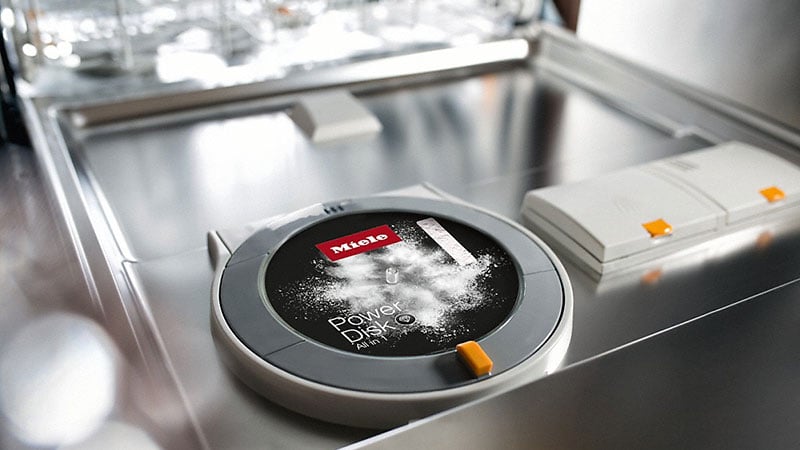
Smart features are common, but most homeowners use only a few.
Auto-dispensing is worth it.
Miele’s AutoDos with PowerDisk automatic detergent system releases the right amount of detergent for each cycle, up to 20 loads per cartridge.
It is limited to Miele’s top-end models, but if you want consistent cleaning with less mess, it is a useful upgrade.
Best Brands for Features
- Miele: The benchmark for reliability, cleaning, and flexibility. Excellent drying and AutoDos dispensing.
- Bosch and Thermador: Quiet and efficient; CrystalDry delivers the best plastic drying on the market.
- KitchenAid: Two solid series—one focused on quiet, another with outstanding racking and the Slant Rack design.
- LG: Strong reliability and performance at a lower price.
- GE Profile and Café Appliances: Attractive midrange choices with effective multi-zone wash options.
Quick Feature Comparison Table
| Why It Matters | Best Brands | |
| Noise Level (<44 dB) | Quiet enough for open kitchens | Miele, Bosch, LG |
| Wash System & Racking | Stainless interior, adjustable racks, strong spray arms | Miele, Bosch, KitchenAid |
| Drying | AutoOpen, CrystalDry, or steam + fan assist actually dries your dishes | Miele, Thermador. LG, Bosch |
| Auto Dispensing | Automatic detergent dosing for up to 20 loads | Miele |
Local Tip
Dishwashers seem simple until you have to install one.
Make sure your dishwasher is flush and paneled correctly, especially for panel-ready models where even a few millimeters off can affect alignment or sealing.
At Yale Appliance, we install hundreds of dishwashers every month throughout Greater Boston, Cape Cod, and Nantucket, including high-end panel-ready units from Miele, Bosch, and KitchenAid.
Click here to download our Free Dishwasher Buying Guide.
You’ll get reliability data, service rates, and brand comparisons based on over 37,000 service calls, plus real installation insights from our team.
In most cases, we can deliver and install your new dishwasher the same or next day if it’s in stock.
Specialty Appliances: The Nice-to-Haves, Not the Must-Haves
You don’t need any of these. Your kitchen will work perfectly fine without them.
If you love to cook or entertain, these upgrades add everyday luxury and a little wow factor.
Pizza Ovens

Pizza ovens have become a lot more popular, and for good reason.
Danny DaSilva, from our Norton showroom, can make a really good pizza in under two minutes.
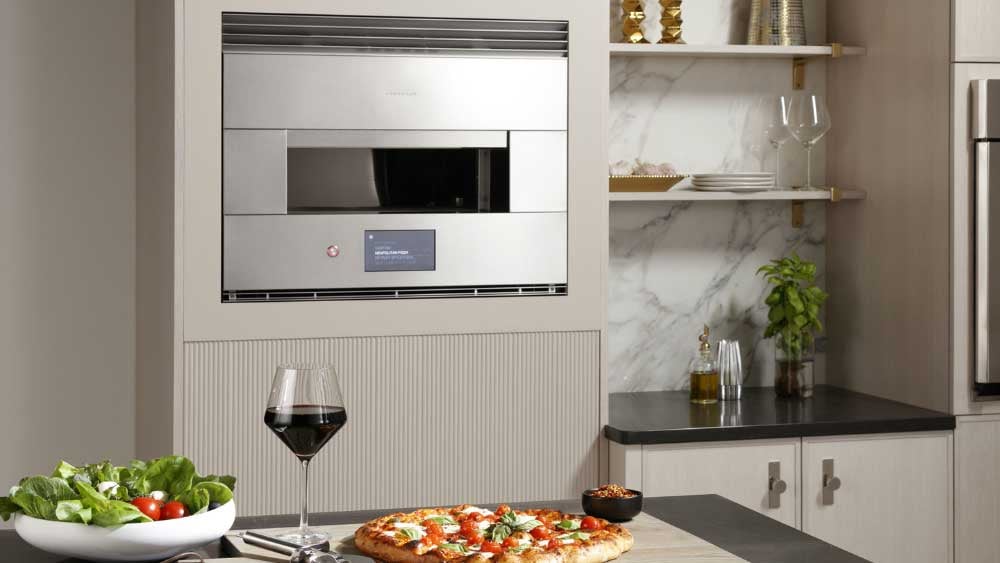
That’s because of the Monogram Hearth Oven. It installs like a wall oven, but heats up to 800 degrees, turning Danny into a pizza chef right in the showroom.
And it’s not just for pizza. You can roast fish, caramelize vegetables, or bake bread for a subtle wood-fired flavor you would not expect indoors.
Pros
✔️Reaches 700–800°F for restaurant-quality pizza
✔️Great for fish, vegetables, and bread
✔️Fast preheat and cook times
✔️Unique showpiece for entertaining
Cons
❌Expensive for a single-purpose appliance
❌Requires strong ventilation
❌Takes time to master heat control
Best Brands: Monogram (Hearth Oven), Wolf (Outdoor), Gozney (Outdoor)
Built-In Coffee Systems
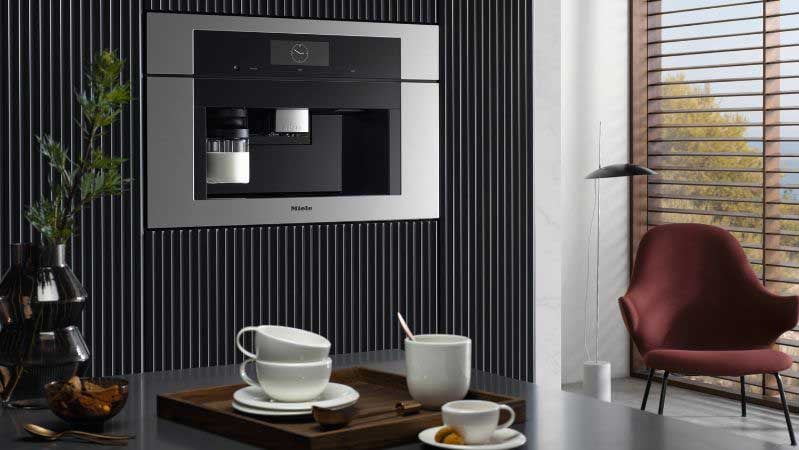
A built-in coffee system is exactly what it sounds like: espresso, cappuccino, and latte at the touch of a button, built into your cabinetry.
My sister makes a blueberry latte worth driving for on the Cape, thanks to her built-in coffee system.
These machines grind fresh beans, froth milk automatically, and let you store drink profiles so everyone gets their perfect order.
Miele’s system is simple to use. Gaggenau offers up to 34 different drinks. Wolf’s version is intuitive and easy to clean.
Pros
✔️One-touch espresso, cappuccino, or latte
✔️Fresh-ground beans and automatic milk frothing
✔️Plumbed or water-tank models available
✔️Saves counter space and adds daily luxury
Cons
❌Requires regular cleaning and descaling
❌Needs cabinet depth planning
❌Pricey upfront (typically $3,000–$5,000)
Best Brands: Miele, Gaggenau, Wolf, Thermador
Warming Drawers

A warming drawer sounds like a luxury, but that changes once you’ve used one.
It keeps food warm without overcooking, perfect for families with staggered schedules or for entertaining.
You can also proof dough or warm plates before serving.
Pros
✔️Keeps food hot without drying
✔️Great for proofing or reheating
✔️Ideal for entertainers or busy families
Cons
❌Limited use if you don’t cook often
❌Takes cabinet space under wall ovens
Best Brands: Wolf, Miele, Monogram, Thermador
Quick Comparison Table
| Best For | Key Benefits | Best Brands | |
| Pizza Oven | Entertaining, fast cooking | 700-800°F heat, wood-fired flavor indoors | Monogram, Wolf |
| Built-In Coffee System | Daily espresso or specialty drinks | Fresh-ground beans, milk frothing, user profiles | Miele, Gaggenau, Wolf |
| Warming Drawer | Busy families, entertainers | Keeps food warm without overcooking | Wolf, Monogram, Miele |
Local Tip
If you want to see these in action, we demo pizza ovens and built-in coffee systems five days a week in our Boston, Framingham, and Norton showrooms.
You can watch Danny make a pizza in two minutes or try a blueberry latte from our built-in coffee machines.
Sinks and Workstations: The First Thing You Choose, and the Last Thing You Use Every Day

We’ll end where most kitchen plans begin: the sink.
It’s often the first topic in design and becomes the center point of how your kitchen works.
I’m an appliance guy, and even I’ll say this: the sink matters more than you think.
You can choose a standard undermount, a farmhouse-style sink for a strong design statement, or a fully accessorized workstation like The Galley or a Yale Appliance sink.
These workstations transform a simple bowl of water into a complete prep and serving station.
The right choice depends on your base cabinet width, typically 24 to 38 inches.
Workstation Sinks: Function Meets Design
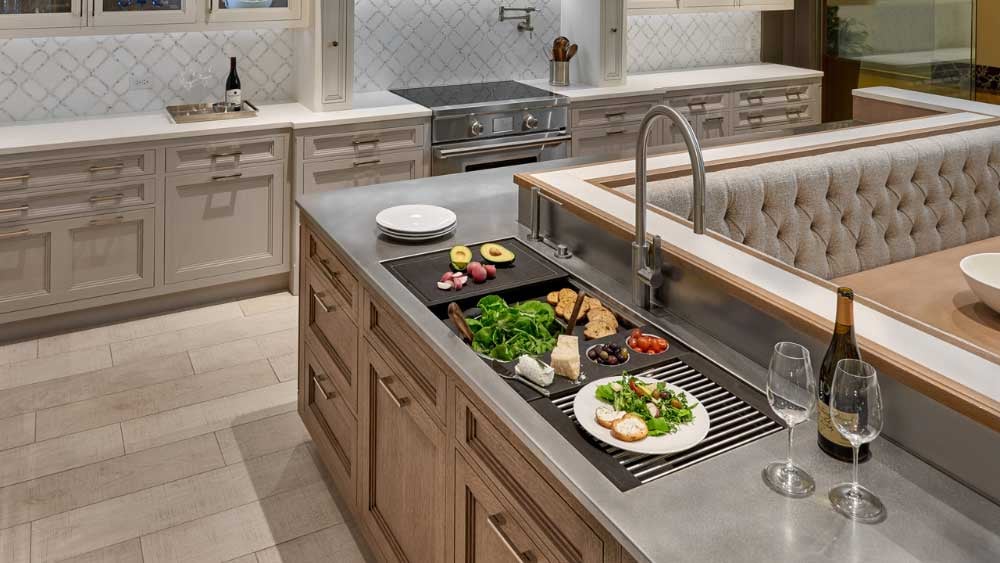
Workstation sinks are one of the biggest upgrades in modern kitchens.
They turn the sink area into a multi-layer prep station with cutting boards, drying racks, strainers, and serving trays that slide and stack.
It’s like adding counter space without adding counters.
The Galley Workstation is the benchmark, available in multiple sizes and configurations with accessories for prep, serve, entertain, and clean.
The Yale Appliance Workstation Sink delivers similar function at a more approachable price, with durable stainless construction and a full accessory package that fits standard 30 to 36 inch cabinets.
Pros
✔️Maximizes counter space and workflow
✔️Keeps prep and cleanup organized
✔️Perfect for small or busy kitchens
✔️Adds a high-end, professional look
Cons
❌More expensive than a standard sink
❌Requires careful cabinet and faucet planning
❌Accessories need occasional cleaning and drying
Best Brands: The Galley, Yale Appliance, Ruvati, Kohler
Farmhouse Sinks: Design Meets Personality

A farmhouse or apron-front sink makes a strong visual statement.
The exposed front panel adds warmth and craftsmanship that pairs with both traditional and modern kitchens.
Materials include fireclay, cast iron, stainless steel, and granite composite, depending on your design and durability preferences.
Best Brands: Kohler, Rohl, Shaws, Elkay
Undermount Sinks: Simple, Clean, Timeless

Undermount sinks sit beneath the countertop for a clean, modern appearance.
They are easy to wipe into, hide the sink edge, and work with almost any countertop material.
Best Brands: Kohler, Yale Appliance, Blanco, Elkay
Quick Comparison Table
| Best For | Look / Function | Typical Widths | |
| Undermount Sink | Most kitchens | Clean, modern look that sits under the countertop | 24-36" |
| Farmhouse (Apron Front) | Traditional or transitional kitchens | Exposed front panel adds character | 30-36" |
| Workstation Sink | Busy kitchens and entertainers | Built-in cutting boards, racks, and inserts | 30-45" |
| Double Bowl | Multi-tasking (soak + rinse) | Divided sections, flexible workflow | 30-36" |
| Single Bowl | Large cookware | One open basin, easy to clean | 27-38" |
Local Tip
Your sink may be the least glamorous choice you make, but it is the one you will use the most.
At Yale Appliance, we display the Galley, Yale Appliance, and Franke sinks in our Boston, Framingham, Hanover, and Hyannis showrooms so you can see how each fits your space and workflow.
🏁 Key Takeaways and Final Thoughts
Choosing appliances and even sinks can feel overwhelming at first.
When you break it down by how you cook, entertain, and live, the process becomes simple.
There is no one best appliance for everyone. The best appliance is the one that fits you, your kitchen, your cooking style, and your home.
Here’s What to Remember
- Start with how you cook. Gas, dual fuel, and induction all have strengths, but only one matches your style.
- Wall ovens and steam ovens make cooking more flexible, especially if you bake or entertain often.
- Ventilation is the unsung hero. A good hood protects your cabinets, your air, and your investment.
- Refrigeration should fit your layout and aesthetic, counter-depth for simplicity, professional for performance, integrated for design.
- Secondary refrigeration adds convenience and luxury without taking space from your main fridge.
- Dishwashers matter most for racking and drying. Quietness is nice, but cleaning and reliability count most.
- Specialty appliances such as pizza ovens or coffee systems are not necessary, but they make cooking and entertaining more enjoyable.
- Sinks and workstations are where design, function, and daily use come together.
The Local Advantage

Buying appliances online looks easy, but the hard part is delivery, installation, and service.
That is where most people run into trouble, and that is where we can help.
At Yale Appliance, we have:
- 18 dedicated delivery and installation teams across Greater Boston, Cape Cod, and Nantucket.
- Six showrooms in Boston, Framingham, Hanover, Hyannis, Norton, and Nantucket where you can see everything working before you buy.
- In most cases, same or next day delivery on in-stock models.
Next Steps
If you are planning your remodel or choosing between brands, start with our free resources.
- Download our Appliance Buying Guide with reliability data, feature comparisons, and insights from over 33,000 service calls.
- Visit a Yale Appliance showroom to see, touch, and test every appliance before you decide.
- Or schedule a consultation, and a specialist will help you design your kitchen around how you cook and live.
When you buy right the first time, you will enjoy your kitchen for years to come.
FAQs
The most commonly asked questions about choosing luxury kitchen appliances for your home.
What’s the best time of year to buy appliances?
Major promotions run on President’s Day, Labor Day, and Black Friday.
However, the best time is often right before model changeovers, usually mid-year, when outgoing inventory is discounted.
Can Yale Appliance install built-in and panel-ready appliances?
Yes. We have 18 dedicated installation teams for panel-ready refrigerators, wall ovens, and pro-style ranges across Greater Boston, Cape Cod, and Nantucket.
We also handle electrical and venting coordination with your contractor to ensure it’s done right the first time.
How do I know what size hood I need?
Match your hood width to your range or cooktop width.
Most 30-inch ranges need 400–600 CFM, while 48-inch professional ranges need 1,200–1,500 CFM.
Our showrooms display live hoods so you can see and hear the difference before you buy.
Which appliance brands are the most reliable?
Based on over 33,000 service calls last year, the most reliable brands are LG, Thermador, Bosch, and GE for dishwashers and laundry, and Sub-Zero for refrigeration.
Reliability also depends on proper installation and strong local service support.
Why should I buy from a local retailer instead of online?
Delivery, installation, and service are the hardest parts of buying appliances.
At Yale, we service what we sell, so you won’t need a 1-800 number or a manufacturer chase.
We deliver, install, and support with one accountable local team, and in most cases, we can do it the same or next day.
Additional Resources
Want a stress-free kitchen project?
Download our free Appliance Buying Guide to learn the right questions to ask before you spend a dollar and gain the confidence to make choices you will love for years.
Over 1 million people have read a Yale Appliance buying guide.
Related Articles:
Why Should You Trust Us?
It seems that every appliance review has nothing but glowing comments about almost every product, yet you read customer reviews and they are almost universally bad.
We are here to fill in the disconnect. We'll give you the best features, and the drawbacks as well, including reliability based on over 37,000 calls performed by our service team just last year. Our goal is to give you ALL the information so you know what's right for you.
Please consider subscribing or adding to the conversation in the comments below. We appreciate you stopping by.
Steve Sheinkopf is the third-generation CEO of Yale Appliance and a lifelong Bostonian. He has over 38 years of experience in the appliance industry, and he is a trusted source of information for consumers on how to buy and repair appliances.
Steve has also been featured in numerous publications, including the
New York Times,
Consumer Reports,
The Boston Globe,
Bloomberg Radio, the
New York Post,
The Wall Street Journal, and
Entrepreneur, for his knowledge of how to buy appliances and appliance repair.
Steve is passionate about helping consumers find the best appliances for their needs, and he is always happy to answer questions and provide advice. He is a valuable resource for consumers who are looking for information on appliance buying, repair, and maintenance.
Despite being the worst goalie in history, Steve is a fan of the Bruins and college hockey, loves to read, and is a Peloton biker. The love of his life is his daughter, Sophie.
A Note About Pricing
Pricing on this blog is for reference only and may include time sensitive rebates. We make every attempt to provide accurate pricing at time of publishing. Please call the stores for most accurate price.
Topics:


